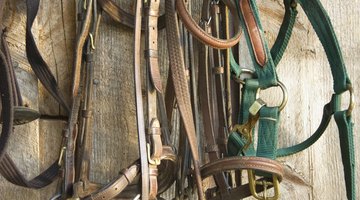Homemade Leather Headstalls
The headstall is the western version of the English bridle; the headstall lacks the noseband, which wraps over the horse’s muzzle. It is not a very complicated leather project, requiring just some heavy-duty cowhide or latigo leather, simple hardware like rings and buckles, and some hours to commit.

You can make your headstall as elegant or simple as you wish. Custom makers offer headstalls with braided horsehair and exotic leathers. But you will likely wish to learn by making a simple, utility headstall before you move on to exotic and show-quality tack.
Patterns
The best pattern for a headstall is a worn-out headstall which you are ready to discard, or a cheap one of man-made materials which you are willing to sacrifice.
Otherwise, you may purchase a pattern from a leather retailer like Tandy Leather Factory. Tandy offers a “Horse Tack Accessory Pattern Pack,” which includes patterns for headstalls, breastplates, throat latches and so on.
Tools and Hardware
You may spend hundreds of dollars on high-end leather tools and handsome hardware, but can likely get by with a few basics.
If you can buy ¾-inch and ½-inch latigo or cowhide straps, you will save yourself a good deal of work. These are available from leather retailers like Tandy Leather Factory and HideCrafter’s Leather Company.
Otherwise, you will require a leather stitching awl; nippers, which create the stitching holes; heavy-duty cording or leather thread (though some craftsmen swear by waxed dental floss); leather glue; an adjustable hole punch; and a rivet setter. Optionally, you may require a strap cutter, which cuts straps out of raw leather; an end cutter, which adds a pleasing conical shape to the end of leather straps; and a skiver, which puts a rounded edge on the sides of the leather straps.
In terms of hardware, you will require leather rivets; buckles in ¾-inch and ½-inch sizes (two apiece); and “Chicago” screws, a heavy-duty two-sided piece of hardware. It serves the same function as a rivet, but you use a screwdriver instead of a rivet gun (which saves some expense).
Leather
You must purchase a rugged leather to make a headstall. Buy an 8- to 10-oz. tooling or latigo leather. Tooling leather is raw but smooth cowhide leather; you can easily dye this to a color you wish. Latigo leather is cowhide that is impregnated with oils and waxes, and is generally brown in color.
The leather, tools and hardware will all be available from a quality leather craft retailer. You will likely spend in excess of $200, while a new headstall typically costs less than $50 (January 2010 prices). Still, you will have the tools and hardware to create more headstalls and tack, and will save yourself hundreds of dollars in the long run.
References
Writer Bio
Dan Antony began his career in the sciences (biotech and materials science) before moving on to business and technology, including a stint as the international marketing manager of an ERP provider. His writing experience includes books on project management, engineering and construction, and the "Internet of Things."
Photo Credits
- Thinkstock/Comstock/Getty Images
- Thinkstock/Comstock/Getty Images
More Articles



